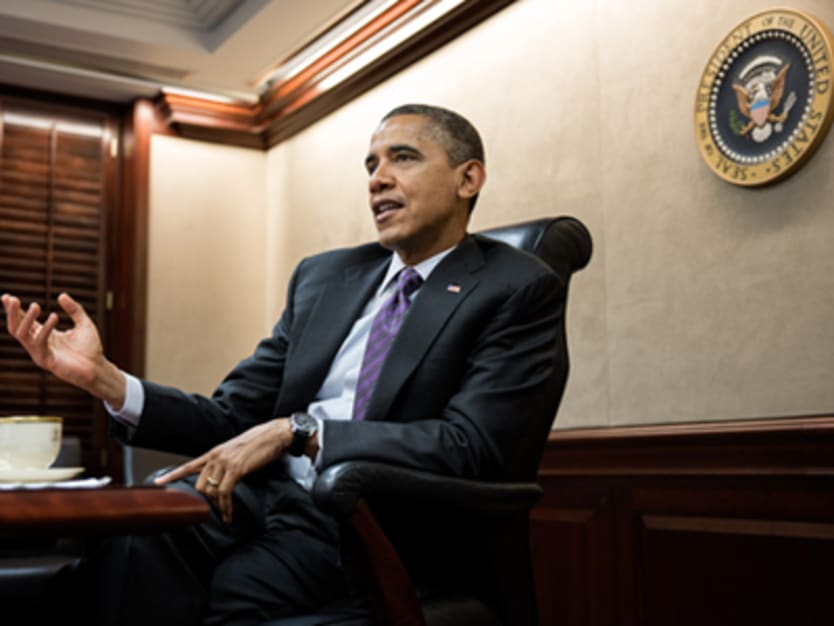
Don’t be fooled by U.S. President Barack Obama’s relatively flat foreign aid budget request for fiscal year 2015.
Between the lines of a modest 1.4 percent decrease from 2014 enacted levels, the Obama administration is bolstering Power Africa partners, cutting U.S. support to some major global health programs and creating a new “global development lab” to spur research and partnerships at the U.S. Agency for International Development.
On Tuesday, Obama released his budget request for fiscal year 2015 — including international development — calling for just over $50 billion for State and Foreign Operations funding next year, which represents a slight $700 million reduction from the 2014 enacted budget.
That reduction is almost entirely explained by cuts to “overseas contingency operations,” which have supported the war in Afghanistan and Pakistan. The base appropriation for other ongoing U.S. development programs has remained at its somewhat elevated level from 2014, after four consecutive years of cuts prior to the omnibus budget agreement late last year.
While that compromise already settled the top line caps on discretionary spending, the new budget request attaches concrete figures to specific accounts — thus giving a clearer picture of the Obama administration’s vision for international engagement through diplomacy and development.
Given the tradeoffs required by a constrained fiscal environment that remains hotly contested during a midterm election year, the U.S. president’s request sets up plenty of winners and losers for 2015.
It also reflects a broad administration appeal for American taxpayers — and Congress — to support a “new model of development” that uses official resources to leverage partnerships and spur institutional reforms in developing and middle income countries to increase the U.S. private sector’s contribution to — and potential profit from — the achievement of economic development goals.
‘The Lab’
The 2015 budget request includes support for creating the U.S. Global Development Lab, a merger of the Office of Science and Technology and the IDEA office at USAID that will apparently cost $146.3 million next year, most of which appears to come from the zeroed-out budgets of its two predecessor offices.
This project — initially dubbed “The Institute” but now known as “The Lab” — is seen by many as a legacy item for Administrator Rajiv Shah, who has strongly advocated for a bigger role for science, technology, innovation, and partnerships in USAID’s portfolio.
“The Lab” will look to scale “major development breakthroughs and [support] a set of initiatives and reforms aimed at transforming the agency into a fully modern development enterprise.”
USAID is reportedly still finalizing the list of “cornerstone partners,” the corporations, universities, foundations, and NGOs who are expected “to jointly sponsor initiatives on innovation, science and technology, and evaluation,” but these will be announced at a launch event later this month, according to an agency spokesperson.
Global health cuts
One of the biggest “losers” in the 2015 budget request is the multilateral Global Fund to Fight AIDS, TB & Malaria, which loses 18 percent of its current U.S. contribution level — down from $1.65 billion to $1.35 billion.
The United States has traditionally been the biggest supporter of organization, pledging to match other international donors’ contributions by a two to one ratio up to $5 billion over three years. Other donations have fallen short of what would be required for the U.S. to reach that $5 billion matching target.
Obama is open to injecting an additional $300 million for the Global Fund, as well as more funding for a number of foreign aid and international affairs accounts — if Congress agrees to support the “Opportunity, Growth, and Security Initiative,” a $56 billion domestic and international spending pool the administration proposes to carve out above the agreed upon discretionary caps by closing tax loopholes they say will make the initiative budget neutral.
The proposal already faces steep opposition on Capitol Hill, so any foreign assistance accounts poised to benefit from its inclusion in an approved appropriations bill would do well not to hold their breath.
Frontline states
Afghanistan, Pakistan and Syria, the so-called “frontline states” received a budget cut in the budget request, as was expected given the Obama administration’s message that the U.S. mission is transitioning away from extensive stability and reconstruction operations and toward a more “normal” relationship focused on long-term economic growth.
The OCO account, which funds programs in Afghanistan, Pakistan and Iraq received a 9.3 percent cut to $5.9 billion.
But the account also became more inclusive, making room for a quarter of OCO funding to support the Syrian opposition and provide humanitarian relief to the war-torn country.
That flexibility in OCO spending could have the added benefit of U.S. relief programs respond to other global hot spots as the need arises, instead of seeing humanitarian assistance funds depleted by the ongoing tragedy in Syria.
Leveraging the private sector, Power Africa
A number of U.S. agencies specifically target private sector partnerships and reforms to drive economic growth, and each of them received a budget increase — some quite significant — under the president’s proposed plan.
The U.S. Trade and Development Agency would see its budget increase by 22 percent if Obama’s request finds traction, a “plus-up” that comes after USTDA’s budget already jumped 19 percent last year. The relatively small agency, which seeks to connect U.S. companies with infrastructure investments in emerging markets, has been lauded from both sides of the political aisle.
The Millennium Challenge Corp., the Overseas Private Investment Corp. and the Export-Import Bank likewise saw budget increases in the 2015 budget request.
Each of these agencies is involved in the whole-of-government Power Africa initiative, a $7 billion U.S. government commitment to help double access to energy in sub-Saharan Africa.
The accompanying budget justification describes a robust role for using the additional funding provided under the president’s request in support of Power Africa’s goals, although some observers have wondered where the $7 billion will come from, and whether it really represents concrete administration commitments or merely aspirational targets.
Each agency’s specific contribution to the initiative cannot be parsed out of the 2015 numbers. However, the budget — together with the recent congressional vote in favor of the bipartisan “Electrify Africa Act,” which directs the president to create a strategy for alleviating energy poverty in Africa –—suggests Power Africa transactions are poised to represent a substantially larger percentage of the U.S. development portfolio next year.
Climate change
The issue of global climate change has risen in profile since Secretary of State John Kerry took office last year, but funding for the Global Climate Change Initiative remained at a flat $840 million in the 2015 request.
The administration has maintained that a significant portion of Power Africa transactions will target clean energy development on the continent, but attempts to strip OPIC of a controversial cap on carbon power investments has led some observers to question whether Power Africa is truly committed to a balanced blend of clean and conventional fuels.
Just as the President’s budget request does not specify how much it will spend directly on Power Africa, it also sheds little light on what portion of Power Africa’s transactions will focus on non-carbon energy sources.
That could leave climate change advocates wondering what’s in it for them — and whether the funding will ever match the rhetoric — when it comes to foreign affairs spending in 2015 and beyond.
Operating expenses, Middle East democracy
USAID receives a more than 20 percent increase to its operating budget in the president’s request, after a 10 percent reduction to that same account in 2014. While agency officials were confident they could sustain current operations using carry over funding this year, they also maintained that surplus funding will be gone by 2015 and that staffing and programs would suffer if the OE budget was not restored.
The agency will have to wait and see if Congress agrees with Obama’s show of support for investing in the agency’s ability to hire new staff and continue funding the USAID Forward agenda, which seeks procurement system reforms and increased agency capacity.
One past administration request — the Middle East North Africa Incentive Fund — has been scrapped in favor of a new, scaled-back version, the Middle East North Africa Initiative Reforms, which will use $225 million to support ”targeted programs that will advance the transitions under way across the region.”
Such pro-democracy language and overt funding for “locally-led change and emerging reformists” could be read as a response to criticism some have leveled at the administration that it has not done enough to support opposition groups and popular movements against entrenched autocrats.
Next steps
The president’s budget request marks the first step in an appropriations process that will play out for months and ultimately determine how the U.S. government prioritizes spending next year.
The proposal is strong on its message about a “new model of development,” which sees opportunities for partnerships with the private sector in spurring development gains, as well as an obligation for U.S. action to respond effectively when global hot spots ignite.
Some signals — the Electrify Africa Act and USTDA’s continued budget plus-ups, for example — suggest bipartisan support exists for the partnerships model of development, at least in some sectors. But it will be important to watch closely to see if the administration is nearly as successful in defending those priorities within the foreign affairs budget — like new emphases on maternal health and child stunting, and global climate change — that do not appear to lend themselves so easily to the mutual economic benefit argument.
Stay tuned as we continue to delve deeper into the ongoing evolution of the U.S. development funding landscape.
Read more on U.S. aid reform online, and subscribe to The Development Newswire to receive top international development headlines from the world’s leading donors, news sources and opinion leaders — emailed to you FREE every business day.








